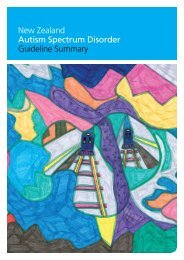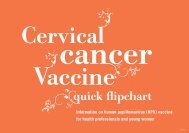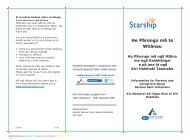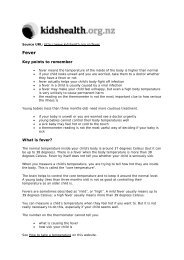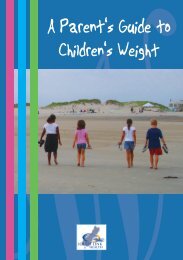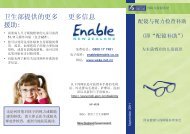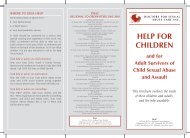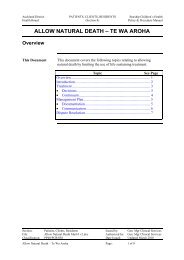New Zealand Autism Spectrum Disorder Guideline - Ministry of Health
New Zealand Autism Spectrum Disorder Guideline - Ministry of Health
New Zealand Autism Spectrum Disorder Guideline - Ministry of Health
Create successful ePaper yourself
Turn your PDF publications into a flip-book with our unique Google optimized e-Paper software.
Part 1: Diagnosis and initial assessment <strong>of</strong> ASD<br />
Part 1<br />
• assessment <strong>of</strong> adaptive functioning (those<br />
skills needed for independent living), also<br />
in order to better understand the person’s<br />
abilities (note that pr<strong>of</strong>essional tests users<br />
should be aware <strong>of</strong> ASD norms for the<br />
Vineland adaptive behaviour scales 47 and<br />
other ASD relevant research 48-50 )<br />
• assessment <strong>of</strong> other forms <strong>of</strong> cognitive<br />
functioning (see below)<br />
• neurological assessment<br />
• mental health assessments<br />
• communication and audiological assessment<br />
• sensory, motor and perceptual assessments<br />
• vision assessment<br />
• occupational and physical therapy evaluation<br />
• evaluation <strong>of</strong> social competence and<br />
functioning<br />
• evaluation <strong>of</strong> interests and activities<br />
19 33<br />
• assessment <strong>of</strong> family resources and needs<br />
34 41 42 51-54<br />
(Recommendation 1.2.4).<br />
The use <strong>of</strong> standardised interviews and<br />
assessment formats for autism, Asperger<br />
syndrome and ASD is supported 55 , and<br />
assessment processes are regularly reviewed<br />
and refined as understanding <strong>of</strong> ASD develops<br />
further 56-59 (Recommendation 1.2.5). Currently,<br />
commonly recommended tools include:<br />
• <strong>Autism</strong> Diagnostic Interview – Revised<br />
(ADI-R), a standardised, semi-structured<br />
clinical review for carers <strong>of</strong> children and<br />
adults suspected <strong>of</strong> having autism or other<br />
58 60-62<br />
pervasive developmental disorders<br />
• <strong>Autism</strong> Diagnostic Observation Schedule<br />
– Generic (ADOS-G), a semi-structured,<br />
standardised assessment <strong>of</strong> social interaction,<br />
communication, play and imaginative use<br />
<strong>of</strong> materials, for use with children and<br />
adults suspected <strong>of</strong> having autism or other<br />
58 63 64<br />
pervasive developmental disorders<br />
• Asperger Syndrome Diagnostic Interview,<br />
a clinician-administered tool for use with<br />
children and adults suspected <strong>of</strong> having<br />
Asperger syndrome or High Functioning<br />
<strong>Autism</strong> 65<br />
• <strong>Autism</strong> <strong>Spectrum</strong> <strong>Disorder</strong> Screening Adults<br />
Questionnaire (ASDASQ), a screening test for<br />
ASD in the adult population 66<br />
• <strong>Autism</strong> <strong>Spectrum</strong> Quotient (AQ), a selfadministered<br />
screening test for people<br />
suspected <strong>of</strong> High Functioning <strong>Autism</strong>/<br />
Asperger syndrome 67<br />
• Australian Scale for Asperger’s syndrome<br />
(ASAS), a checklist for parents <strong>of</strong> primary<br />
school children suspected <strong>of</strong> having Asperger<br />
syndrome 68<br />
• Childhood Asperger Syndrome Test (CAST),<br />
a parent-completed screening test for children<br />
aged 5–11 years 69<br />
• Developmental, Diagnostic and Dimensional<br />
Interview (3di), a computerised assessment<br />
for autism spectrum disorders 70<br />
• Diagnostic Interview for Social and<br />
Communicative <strong>Disorder</strong>s (DISCO),<br />
a clinician-administered schedule <strong>of</strong><br />
71 72<br />
assessment for use with people <strong>of</strong> all ages<br />
• Gilliam Asperger’s <strong>Disorder</strong> Scale (GADS),<br />
a scale for use by parents and pr<strong>of</strong>essionals,<br />
assessing Asperger syndrome in people aged<br />
3–22 years 73<br />
• Krug Asperger’s <strong>Disorder</strong> Index (KADI),<br />
a scale for use by pr<strong>of</strong>essionals, assessing<br />
Asperger syndrome in people aged 6–22<br />
years 74 .<br />
Many <strong>of</strong> the tests above are subject to ongoing<br />
review and limitations are described in the<br />
literature and Appendix 5. Many <strong>of</strong> the<br />
tools require specialist education which<br />
is not currently available in <strong>New</strong> <strong>Zealand</strong><br />
(Recommendation 1.2.6, Recommendation 6.2,<br />
Pr<strong>of</strong>essional learning and development).<br />
Theory and research on the nature <strong>of</strong> ASD is<br />
complex, controversial and ongoing 75 76 . The<br />
three main theoretical approaches are:<br />
• disturbance in theory <strong>of</strong> mind or<br />
‘mindblindness’: impaired ability to reflect on<br />
the contents <strong>of</strong> one’s own and others’ minds 77<br />
• weak central coherence theory: the difficulty<br />
that people with ASD have in cognitively<br />
‘seeing the big picture’, and their focus on the<br />
smallest possible parts<br />
52<br />
<strong>New</strong> <strong>Zealand</strong> <strong>Autism</strong> <strong>Spectrum</strong> <strong>Disorder</strong> <strong>Guideline</strong>



